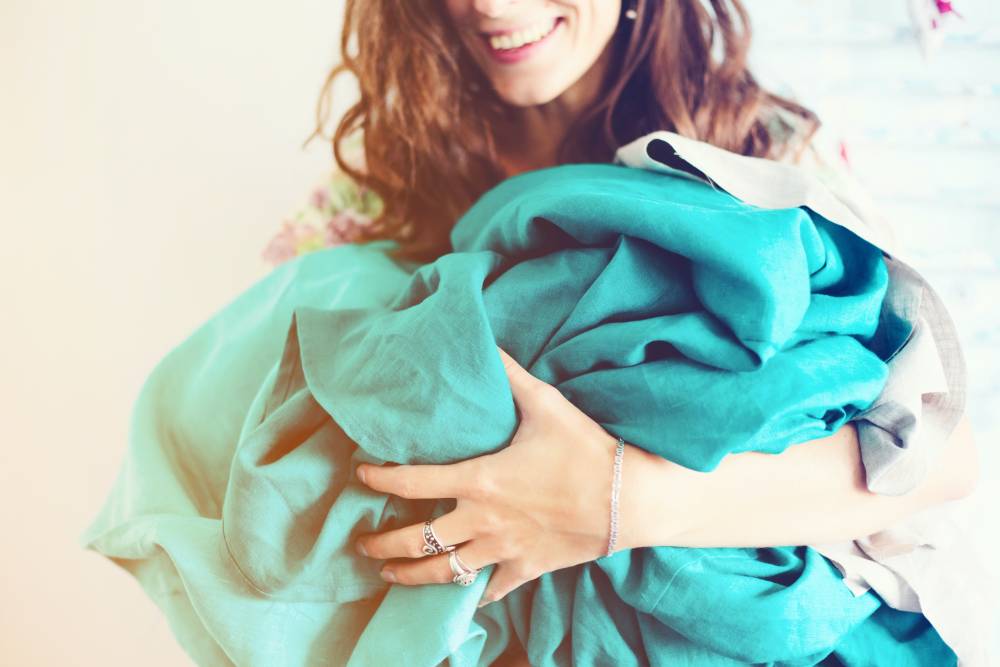
Hemp and linen are both great choices for eco-friendly and sustainable fabrics. They are often used in the fashion industry to make beautiful and stylish garments that also protect the environment.
Linen and hemp are fabrics made from the natural fibers of flax and hemp plants respectively. They are both expensive with quite low availability. But linen is more popular than hemp. It represents luxury while hemp still has a bad reputation.
Linen and hemp often make high-quality and environmentally friendly clothes. They are great natural materials made from renewable resources.
Fashion brands and designers use hemp and linen worldwide to design and produce comfortable and luxurious clothing.
But they are less widespread than other natural fibers such as cotton, or jute. Even if they offer wonderful qualities for clothing, they also have a few disadvantages.
The textile and apparel industry has a catastrophic impact on climate change. It's responsible for huge amounts of carbon emissions, pollution, and waste.
Luckily, the green movement is booming globally, including in the fashion world. Conscious consumers are asking for more eco-friendly products, made from sustainable materials.
To answer consumers' demand, fashion brands and retailers offer eco-responsible and fairly produced clothing and accessories. Hemp and linen are formidable options to produce sustainable apparel.
Here is a comparison between linen and hemp with some key differences.
Panaprium is independent and reader supported. If you buy something through our link, we may earn a commission. If you can, please support us on a monthly basis. It takes less than a minute to set up, and you will be making a big impact every single month. Thank you!
Natural linen and flax fabrics
Linen is an ancient fabric that was already used 6,000 years ago. It's made from flax plants harvested annually, about a hundred days after seed planting.
Linen accounts for less than 1% of all textile fibers consumed globally. It's a natural material affected by slow, complex, and costly manufacturing processes.
Check out my article on why linen is so expensive to understand the factors contributing to its high price.
The annual production of flax fibers rose to more than 868,000 tons worldwide in 2018. This amount is very low compared to cotton (30,3 million tons) and jute (3,63 million tons).
Europe produces more than 85% of all flax fibers globally. France is the most prominent producer of flax with about 660,000 tons produced in 2018, followed by Belgium, Belarus, and Russia.
Linen clothing is considered a luxurious fabric and is particularly cool in warm weather. It's used for clothing as well as household articles such as curtains, tablecloths, bedsheets, and wall coverings.
Linen cloth is well-known to be durable, comfortable, resistant, lightweight, breathable, and very absorbent.
Read up my article on the natural color of linen for more information about linen usage and qualities.
The principal drawback of linen is its low elasticity. Linen can wrinkle easily. That's why it's often blended with other materials.
The costs of linen fabric production are twice as high as cotton fabric production. The machinery has to run quite slow to weave flax fibers into linen fabric. They are broken easily.
Linen fabric is oftentimes very environmentally friendly. It's a natural fiber, biodegradable, and recyclable.
The flax plant needs limited amounts of water to grow unless the weather is especially warm. 6.4 liters of water are needed to make a linen shirt compared to 26 liters for a cotton shirt.
It's a good idea to look for Fair Trade and certified organic linen when shopping for linen clothing. These standards attest that no harsh chemicals were used and workers were treated equitably.
Read up my guide on the best eco-certification standards for textiles to learn more about certifications for sustainable clothing.

Hemp vs linen
Buying and wearing hemp clothes is a great way to decrease the environmental footprint of our wardrobe. They are ethical and sustainable but remain in low demand compared to other clothing made from natural fibers such as linen.
Hemp plants used to make hemp fibers grow in temperate climates and are also harvested annually. There aren't many hemp products available globally because industrial hemp farming is a very small industry.
The annual production of hemp fibers was 60,657 tons in 2018 globally. That number is more than 10 times lower than for flax fibers.
The biggest producer of hemp tow worldwide is North Korea with 14,891 tons produced in 2018, followed by the Netherlands, China, and Italy.
Just like linen, hemp fabric is very absorbent, lightweight, resistant, and breathable. It also wrinkles easily and requires chemical treatments to remain elastic.
Read up my article on the top 5 reasons why organic hemp clothing is so expensive to learn more about hemp fashion products.
Hemp clothing isn't very popular as the distinction between hemp and marijuana isn't very clear to most people. The hemp plant is a very distinct variety of the cannabis plant. Hemp fibers aren't made from the same plant as marijuana at all.
But hemp is one of the most environmentally friendly fibers in the world. It has a very high yield, is very versatile, and requires little water to grow. Hemp textiles are natural, bio-based, and biodegradable. And hemp plants usually grow with almost no pesticides or fertilizers.
The Higg Materials Sustainability Index attributes to hemp and linen a very similar total impact score of 160 and 162 respectively. They have almost the same low impact on global warming, soil eutrophication, and water scarcity.
While linen cloth represents luxury, preciousness, extravagance, wealth, and authority since history, hemp still has a bad reputation. It's tough to talk about hemp in many situations. The term is often forbidden in forums and advertising platforms.

Overall, hemp and linen make great choices for environmentally friendly clothing. They are both expensive and have limited availability, unfortunately.
Only a few fashion brands and designers offer clothing pieces made from hemp. Linen is much more popular than hemp and benefits from a larger acceptance by consumers.
Conscious buyers looking for sustainable and eco-friendly clothing don't pick hemp as a first choice.
Organic cotton remains is the most popular natural and eco-friendly fiber, even though hemp plants grow faster than cotton and require much less water, pesticides, and fertilizers before harvest.
Do you already know own any hemp or linen clothing piece? What are your thoughts about it? Let us know in the comment section below.
Was this article helpful to you? Please tell us what you liked or didn't like in the comments below.
About the Author: Alex Assoune
What We're Up Against
Multinational corporations overproducing cheap products in the poorest countries.
Huge factories with sweatshop-like conditions underpaying workers.
Media conglomerates promoting unethical, unsustainable products.
Bad actors encouraging overconsumption through oblivious behavior.
- - - -
Thankfully, we've got our supporters, including you.
Panaprium is funded by readers like you who want to join us in our mission to make the world entirely sustainable.
If you can, please support us on a monthly basis. It takes less than a minute to set up, and you will be making a big impact every single month. Thank you.































0 comments